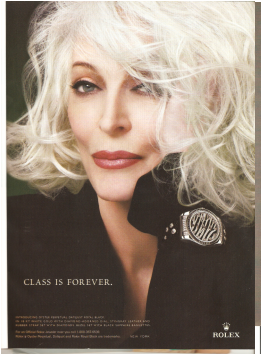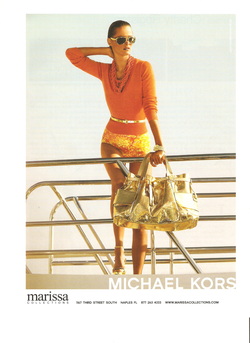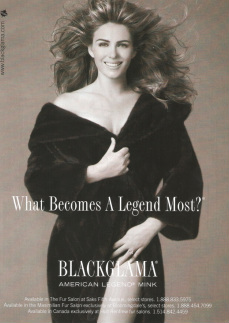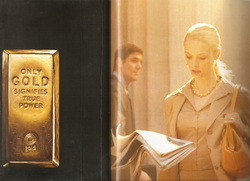Advertising Propaganda: Hasty Generalizations in the Fashion Industry
By Rachel Collins

Flipping through the pages of last year’s spring edition of Vogue, I found myself staring at the pictures more than I was reading the articles. Although advertisements make up over half of the haute couture magazine, one can spend hours simply looking at the innovative designs and wacky poses the models make. When it comes to high end fashion advertising, words are hardly ever needed. The clothes themselves make a statement; they say “Here!” “Look at me, your alter-ego would love this outfit!” It’s funny how one will come to love a design they see in the picture even though it’s something they would have walked right by if it were hanging on a department store rack. How do the advertising companies do it? How do they appeal to our alter egos and make us desire clothing we would have otherwise looked right passed? Although there are hundreds of techniques used by various designers and marketing agencies, I discovered while flipping through Vogue’s pages, that many of them use hasty generalizations. These generalizations imprint false ideas in the viewer’s mind. Generalizations paint a picture of what something, say a type of person, should be doing, wearing and looking like. As a result, the reader will either love the look and strive to mimic it, or they will turn their nose up and flip the page.
Hasty generalizations are often made by one’s own prejudices. “A prejudice is literally a judgment made before the facts are in” (338). Vanity Fair, a sister magazine to Vogue, is another one that boasts sophistication and waste. Over two thirds of the magazine is fashion advertising alone. After I sat on my bed and opened it up, it did not take long for me to come across an ad that screamed “hasty generalization”. Page fifteen of the July 2008 issue, Rolex sinks its teeth into the wealthy, middle aged woman. Grey hair covers the upper right half of the page as a woman who looks to be in her early sixties stares seductively. Although she is over sixty, there is not a wrinkle to be seen, her lips are full, and her skin firm, it’s as if it were a testimonial for the fountain of youth. On her wrist, over her long, black, silk sleeve is the Rolex securely wrapped. On the left side of the page it reads, “Class is forever.” What makes this women classy” Rolex’s hasty generalization is that all classy women look like this; with collagen- enhanced lips, Botox-filled wrinkles, long, non-thinning grey hair and a diamond encrusted watch. Similar to a stereotype, this generalization places wealthy women with too much plastic surgery, who are desperate to hang on to their youth, as the “classy ones”, the watch is just simply an added bonus.
When one cannot measure up to the standards marketing companies place on society, they fill the void by buying merchandise. We are a consumer market striving to be what the media teaches us to be. In a recent study, “High self-monitoring individuals reacted more favorably to image-oriented advertisements, were willing to pay more for products if they were advertised with an image orientation, and were more willing to try a product if it was marketed with an image appeal” (DeBono). Images create emotions, that is why so many high fashion ads simply show a model in their clothing rather than a picture and a description. In another study, scientists observed the effect certain fashion advertisements had on those that viewed them. “Findings show a unique set of three emotional dimensions generated by the apparel brand advertisements. Two emotional dimensions, pleasure/activation (eg activation, bored, desired, social affection) and hypoactivation (drowsy, restful, soothed), had a positive influence on ad attitude. The third dimension, domination (anger, fear, irritation, tension), did not have a significant effect on ad attitude, having neither good nor bad effect on evaluations of advertisements” (Kim). These are only a few of the emotions consumers feel when they see a fashion image. A desire, want, and need is created. It is only human to want to fit in someplace within society. Fashion gives you those options and portrays them in their advertising. If one wants to be angelic and innocent, they use hazy lighting and white fabric. If one wishes to be sexy, they use metallic colors and dark, sultry eyes, because these are the general looks of such stereotypes.
Hasty generalizations are often made by one’s own prejudices. “A prejudice is literally a judgment made before the facts are in” (338). Vanity Fair, a sister magazine to Vogue, is another one that boasts sophistication and waste. Over two thirds of the magazine is fashion advertising alone. After I sat on my bed and opened it up, it did not take long for me to come across an ad that screamed “hasty generalization”. Page fifteen of the July 2008 issue, Rolex sinks its teeth into the wealthy, middle aged woman. Grey hair covers the upper right half of the page as a woman who looks to be in her early sixties stares seductively. Although she is over sixty, there is not a wrinkle to be seen, her lips are full, and her skin firm, it’s as if it were a testimonial for the fountain of youth. On her wrist, over her long, black, silk sleeve is the Rolex securely wrapped. On the left side of the page it reads, “Class is forever.” What makes this women classy” Rolex’s hasty generalization is that all classy women look like this; with collagen- enhanced lips, Botox-filled wrinkles, long, non-thinning grey hair and a diamond encrusted watch. Similar to a stereotype, this generalization places wealthy women with too much plastic surgery, who are desperate to hang on to their youth, as the “classy ones”, the watch is just simply an added bonus.
When one cannot measure up to the standards marketing companies place on society, they fill the void by buying merchandise. We are a consumer market striving to be what the media teaches us to be. In a recent study, “High self-monitoring individuals reacted more favorably to image-oriented advertisements, were willing to pay more for products if they were advertised with an image orientation, and were more willing to try a product if it was marketed with an image appeal” (DeBono). Images create emotions, that is why so many high fashion ads simply show a model in their clothing rather than a picture and a description. In another study, scientists observed the effect certain fashion advertisements had on those that viewed them. “Findings show a unique set of three emotional dimensions generated by the apparel brand advertisements. Two emotional dimensions, pleasure/activation (eg activation, bored, desired, social affection) and hypoactivation (drowsy, restful, soothed), had a positive influence on ad attitude. The third dimension, domination (anger, fear, irritation, tension), did not have a significant effect on ad attitude, having neither good nor bad effect on evaluations of advertisements” (Kim). These are only a few of the emotions consumers feel when they see a fashion image. A desire, want, and need is created. It is only human to want to fit in someplace within society. Fashion gives you those options and portrays them in their advertising. If one wants to be angelic and innocent, they use hazy lighting and white fabric. If one wishes to be sexy, they use metallic colors and dark, sultry eyes, because these are the general looks of such stereotypes.
Clic here to edit.

When looking for generalizations in fashion advertising, many times it is not who the designer is or what statement the outfit makes, but rather what magazine the ad is in. Naples Illustrated is a high end publication local to Southwest Florida. It features multi-million dollar homes, exclusive boutiques, custom made jewelry and the socialites of the beautiful, ultra savvy town of Naples. In the February 2008 issue, Michael Kors debuts his latest summer collection and handbag. The ad depicts what many would label as an “elite” woman wearing aviator sun glasses, bright colored swim suit bottoms, and holding a metallic gold beach bag while she looks over the side of a yacht. The fact that the ad is in a magazine that highlights an “elite” town in Florida suggests that the model too, is just that. They generalize all who live in Naples. They are expected to look and wear this quality while cruising on their yacht in the Gulf.
lick here to edit.

Elisabeth Taylor, Rita Hayworth, Vivian Leigh and Jean Harlow; some of America’s leading ladies that decorated the movie screens in the early twentieth century. Each of these timeless ladies made Hollywood what it is today, they were royalty. If you were to Google images of the “bombshells” they would be adorned in jewels and luxurious fur. So much fur in fact, PETA would have rioted outside of the studios. No matter the actress, back then, fur signified fame, wealth, and glamour. In the October edition of Vogue magazine, those of Blackglama remind us of this glittering, hasty generalization. Elizabeth Hurley takes center stage for their mink advertisement. With her long, brunette hair flowing freely, she is wearing nothing but a long, black mink coat. What does this signify? All great actresses wear fur, and according to Blackglama, it is an “American legend” as stated on the bottom of the page.
lick here to edit.

While most advertisements are discreet about their generalizations, some are bold and come right out with it. In the May 2007 edition of Vogue, Gurhan jewelry has a picture of a business woman carrying the daily newspaper and a set of gold earrings and necklace that enhance the frame of her face. On the opposite page, in a solid gold bar, it states “Only gold signifies true power.” Not only does this precious metal signify wealth and power, but the fact that the model is a business woman goes to make yet another hasty generalization. In order be worthy of purchasing this gold set to signify power, one must be in a position that has power in the first place, thus a businesswoman is generalized to hold this stature.
The moment we meet someone, we create an opinion of them; we judge them, we stereotype them. The same is done when we view fashion advertising. We see the clothing or the model and instantly desire to be like them. Edgy, chic, powerful, innocent, sexy, bold, classy, simple, eccentric, eclectic, sophisticated; you are what you wear. Fashion marketers use hasty generalizations to evoke these emotions within us consumers. Without this desire to fit in and find our niche, designers would go out of business. Whether one buys a Rolex to be classy, a mink coat to be glamorous or a gold necklace to be powerful, they all fall victim to advertising’s psychological tricks.
The moment we meet someone, we create an opinion of them; we judge them, we stereotype them. The same is done when we view fashion advertising. We see the clothing or the model and instantly desire to be like them. Edgy, chic, powerful, innocent, sexy, bold, classy, simple, eccentric, eclectic, sophisticated; you are what you wear. Fashion marketers use hasty generalizations to evoke these emotions within us consumers. Without this desire to fit in and find our niche, designers would go out of business. Whether one buys a Rolex to be classy, a mink coat to be glamorous or a gold necklace to be powerful, they all fall victim to advertising’s psychological tricks.
Debono, Kenneth G. “Appeals to Image and Claims About Quality: Understanding the Psychology of Advertising”. Journal of Personality and Social Psychology Volume 49, Issue 3, September 1985, Pages 586-597. 19 Feb 2011. Web.
Kim, Hye-Shin. “Examination of emotional response to apparel brand advertisements”. Journal of Fashion Marketing and Management. Vol. 4 Iss: 4, pp.303 – 313. 19 Feb 2011. Web.
Rottenberg, Annette, and Donna Wiuchell. Elements of Argument. Print.
Kim, Hye-Shin. “Examination of emotional response to apparel brand advertisements”. Journal of Fashion Marketing and Management. Vol. 4 Iss: 4, pp.303 – 313. 19 Feb 2011. Web.
Rottenberg, Annette, and Donna Wiuchell. Elements of Argument. Print.
